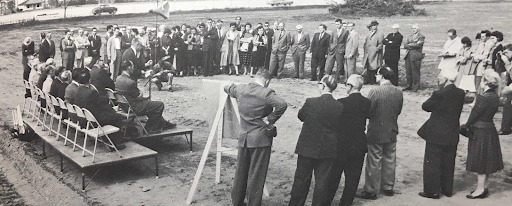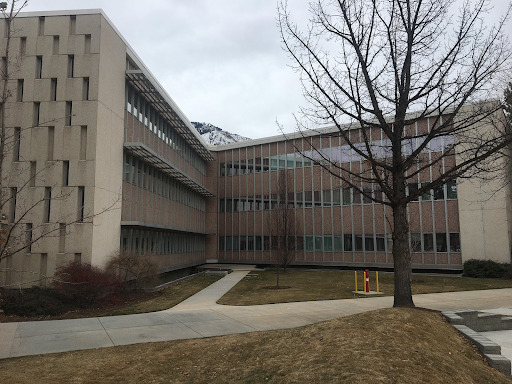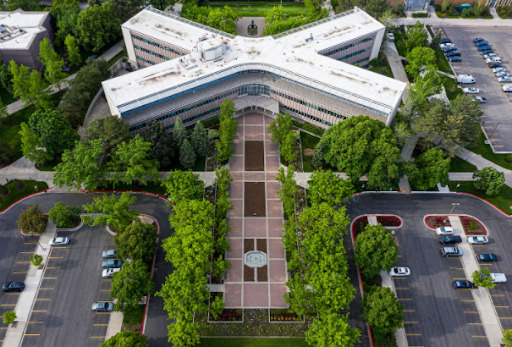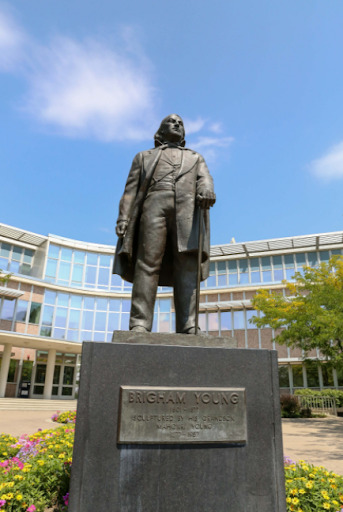Smoot (Abraham O.) Administration Building (ASB)

Following the First Presidency’s 1957 affirmation that they wanted Brigham Young University to be “the greatest educational institute in the world,” an ambitious “master plan” detailing BYU expansion was revealed. This plan called for the construction of many new facilities, including a new building for university administration.
BYU’s Maeser Memorial Building housed the offices of university administrative leaders for decades. However, as the university grew, more space was required. Construction on a new university administration building began in October 1959. While initial plans detailed a “conventionally styled two- or three-story building, ‘strong, imposing, [and] conservative,’” architect Henry P. Fetzer surprised the Board of Trustees with plans for a more radically designed building. His innovative “x” floorplan” facilitated easy movement between offices without disturbing others. Also, the shape allowed for different areas of administration to be housed in one of the four arms of the building, preventing unnecessary movement between floors.
The 100,000 square foot building was constructed from precast concrete and white cast stone. Completed in 1961 and dedicated on October 10th, 1962, the new structure housed 250 offices for BYU administration and faculty. This not only provided enough space for the growth of university administration, but also made room for the English and Archaeology Departments to move into the Maeser Building.
Forming one side of “the quad,” the new administration building occupies a prominent position on campus. Sam Brewster, BYU’s Director of the Physical Plant Department, called the quad “one of the finest quadrangles in the nation.” From the south side of the administration building looking out over the quad, stands a 7 ½ foot tall, 1,300 pound statue of the university’s namesake, Brigham Young. The statue was cast from the plaster original, made by Mahonri Young, the prophet’s grandson. The north side of the building features a fountain and flower garden.
The new structure was named the “Abraham O. Smoot Administration and General Services Building'' in honor of the late local leader. Smoot was the second mayor of Salt Lake City, and later the mayor of Provo, and a Provo stake president. Smoot was also the president of the original trustees of Brigham Young Academy. Through his contributions, Smoot helped to save the institution from financial ruin. Soon before his death he declared, “I love that school… It must live.” If it were not for Smoot’s determination to take upon himself the role of “Foster Father of the Academy,” it is likely that BYU would not exist today.
With Smoot as its namesake, it is fitting that the interior of the building, while exhibiting the calculated practicality of the architect, offers visitors glimpses of BYU history. A display in the administration building’s main lobby contains photographs, stories, and artifacts from the life of Abraham Smoot. On the third floor, which houses the office of the university president, hang paintings of past BYU presidents.
Although a prominent figure in BYU’s history, Smoot’s involvement with slavery looms over his legacy of service and philanthropy. Smoot is known to have owned at least one slave. Given Smoot’s complicated legacy, some people question if he’s an appropriate namesake for a university building. In June 2019, news broke that several students were petitioning to urge BYU administration to meet with representatives from the wider BYU community to open a dialogue to discuss renaming the administration building. While the petition made headlines across Utah, BYU administration has not openly addressed the controversy. However, in February 2021 BYU President Kevin Worthen announced the release of results from a study and a survey conducted by the BYU Committee on Race, Equity & Belonging. These endeavors, which included survey data from nearly 20,000 respondents, “were designed to help the university better understand and address people’s experiences with diversity and belonging, as well as to develop plans to improve the campus experience for all students and employees.” The findings acknowledge racism in the BYU community and outline steps for how BYU can improve and become even more inclusive. Among its recommendations, the committee suggests renaming BYU buildings to reflect their function, rather than to continue to honor specific people.
For now at least, the BYU Administration Building continues to bear the name of Abraham Smoot.
Images






This statue was the work of the prophet’s grandson, Mahonri Young. Source: “Brigham Young Statue on BYU Campus.” The Daily Universe , Brigham Young University. https://universe.byu.edu/wp-content/uploads/2014/08/BYUCampus_19.jpg